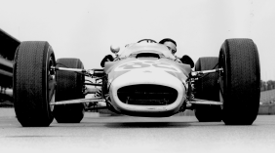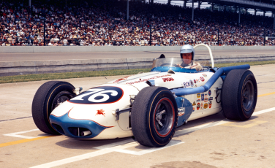In the build up to the 2014 Indianapolis 500, The Checkered Flag is looking back on significant races that have contributed to the glorious history of the 97 500s that have been and gone.
————-
A dozen years after the roadster era with Bill Vukovich’s first Indy 500 victory it was another man whose racing career would, ultimately, be tragically cut short who eschewed in a new era.
Since Jim Clark brought his Lotus 38 into victory lane on May 31 1965 every winner of the Indy 500 has been in a car with the engine behind the driver. The sea change from the front engine cars of the past decades to the mid-engined Lotus, a comparatively tiny chassis slung between off-set suspension designed to help the car through the turns, seems a sudden swing on paper, but victory for a rear-engined car in 1965 was almost inevitable the race coming as it did when the rear engine takeover of Indy was almost complete.
The history of rear engine machines in the 500 goes back to 1941 when George Barringer qualified his ungainly looking Miller powered creation a creditable 18th fastest. However a garage fire on race day morning reduced the car to a charred chassis, leaving the 500 to wait another 20 years until a rear engine car would return to the speedway with the defending World Champion Jack Brabham at the wheel of a Cooper T54 powered by a Coventry Climax engine. He finished ninth – the seeds of the revolution had ben sewn – and where Brabham and Cooper had laid the foundations other built on them.
Dan Gurney made his first 500 start the year later in a Mickey Thompson designed chassis pushed along by a Buick engine, with Clark and Lotus making their 500 debuts the following year. Only Clark and a pair of Thompson’s ill-fated designs were in a field still dominated by the roadsters, which were able to generate a higher top speed. Still Clark started fifth and finished second, then claimed pole for the 1964 race and was leading when his car’s suspension broke. The occurrence was typical of Clark’s ’64 season in which repeated mechanical failures prevented him from defending his world title.

Clark peers round the front of the new-for-’65 Lotus 38 (Credit: Indycar Media)
For ’65 Clark had a brand new Lotus-Ford, fitted with a pair of twisting bright yellow tail pipes, but faced a field not only populated by European imports, including five other Lotus, but home grown chassis from stables such as Halibrand, Gerhardt, Huffaker and Brawner.
Among the 33 that qualified for the race only a handful of roadsters remained including the final appearance of the Novi V8 in a pair of year old machines. The troublesome Novi turned in a typically recalcitrant showing both of the STP sponsored cars retiring before the half way point. Bobby Unser, having already lost his primary car in practice retired just 69 laps in while Jim Hurtubise failed to complete the first lap at racing speed. Hurtubise, having come back to racing after serious injury, would go on to take a footnote in history in 1977 as his failed qualifying attempt finally brought front engine cars’ involvement at Indy to a close.

Gordon Johncock was a member of a bumper rookie class (Credit: Indycar Media)
Roadsters also propelled some of a bumper rookie class that included future four time winner Al Unser, future double winner Gordon Johncock and Mario Andretti.
In a rear engined Brawner Andretti would win rookie of the year honours with a third place finish.
Qualifying – and the early exchanges of the race – was a battle between Clark and A.J. Foyt, the latter coming into the race as defending champion. However, Foyt had jumped from the Watson roadster to a year old Lotus to defend his total, a sign of where teams and drivers saw the balance of power tilting.
Foyt took the pole position with a new record four lap average of 161.233mph with Clark and Gurney completing an all-Lotus front row. Gurney had been Clark’s teammate in the works Lotus team the year earlier, though that spot in ’65 was taken by NASCAR regular Bobby Johns. Johns was not the only NASCAR implant in the Lotus team engine supplier Ford calling the Wood Brothers’ pit crew across from stock cars.
While drafting in the Woods – accepted as one of the best pit crews in NASCAR at the time – certainly had a role to play in securing a victory in a race where refuelling pitstops had taken on a new importance after a raft of rule changes all signs already pointed to a Ford engine ending the Month of May in victory lane. Not only did they have the numerical edge in the field with 17 cars (all rear engined) carrying the blue oval marque by they had the measure on performance, going better than Lotus in qualifying with Andretti and Parnelli Jones completing a Ford top five ahead of the best of the ten cars packing the Offenhauser in the rear of a chassis in the Vollstedt of rookie Billy Foster.

Clark leads Foyt and Jones in the early laps (Credit: Indycar Media)
From the middle of the front row Clark squirted out into the lead on lap one, only for Foyt to retake the position in time to lead the second lap before Clark moved back ahead and began to slowly edge away into a lead he had to give up when he called his pit crew into action for the first time.
Foyt led for nine laps before he too pitted for the first time, giving Clark back a lead he would keep for the remainder of the race, heading the way for a total of 190 laps during the afternoon. Foyt, his nearest challenger, bowed out of the race with a mechanical failure shortly after the half way point leaving Clark to win by nearly two minutes. The man who had denied the Scot victory in his rookie year – Parnelli Jones – finished second in a Kuzma-Lotus ahead of Andretti.
Al Miller in another Lotus completed a top four for Ford with Johncock hauling a near obsolete Watson-Offy roadster to fifth place, the last man to complete the 500 miles on the day.
If Ford’s domination of the race looked as though it had pried loose the Offenhauser’s grip on the Indy 500 at the same time as defeating the roadsters it proved to be a false dawn. The classic four-pot would return to victory lane at the speedway in the years to come.
Admitting that Clark’s dominant victory only rubber stamped the rear engine domination of Indy that was clear from the entry list his victory did open one – short lived – era at the Speedway as F1 drivers made their way to Indianapolis.
Graham Hill won the 500 the following year and before the decade was done Jackie Stewart, Denny Hulme and Jochen Rindt had all lined up in the fastest 33.
www.theCheckeredFlag.co.uk will be providing full coverage of the 98th Indy 500 both on Twitter at @TheCheckerFlag as well as here on the website.



